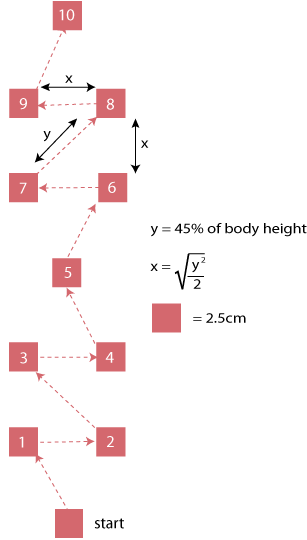The Multiple Single-Leg Hop-Stabilization Test (MSLHST) is a dynamic and static balance test used to examine the balance capabilities of an athlete, one leg at a time. The test was designed for the sporting population and based on the similar BASS balance Test. The test involves performing dynamic forward and diagonal one-legged jumps while statically maintaining landing positions.
test purpose: to measure whole body dynamic and static balance
equipment required: A flat, smooth, non-slip surface, measuring tape, marking tape, metronome.
pre-test: Explain the test procedures to the subject. Perform screening of health risks and obtain informed consent. Prepare forms and record basic information such as age, height, body weight, gender, test conditions. Perform an appropriate warm-up. See more details of pre-test procedures.
test layout: The markers are set out as illustrated. The distances between the markers are calculated based on the participant's standing height. The longest jumping distance (y), is set at 45% of the participant's body height measured in shoes. The sideways and forward jumps (x) are of equal distance, calculated as listed (based on Pythagorean Theorem).
 procedure: The subject starts by standing on one foot on the start marker, looking straight ahead. Both hands are rested on the hips and stay there for the duration of the test. A metronome gives an audio cue every second to assist with the timing. When instructed, the subject hops to the next marker, and land covering the marker with the foot entirely. Eyes should be looking straight ahead while maintaining the position for five seconds before advancing to the next marker. The test continues following the numbered order of the markers as depicted in the figure. Repeat the test for the other leg.
procedure: The subject starts by standing on one foot on the start marker, looking straight ahead. Both hands are rested on the hips and stay there for the duration of the test. A metronome gives an audio cue every second to assist with the timing. When instructed, the subject hops to the next marker, and land covering the marker with the foot entirely. Eyes should be looking straight ahead while maintaining the position for five seconds before advancing to the next marker. The test continues following the numbered order of the markers as depicted in the figure. Repeat the test for the other leg.
scoring: Assessors use the Balance Error Scoring System (BESS), as described in the grid below. Any errors during any of the jumps are recorded using the marking grid. Landing errors can be up to 3 points per landing, and balance errors up to 10 points per landing. For the 10 marker jumps, there is a possible maximum of 130 error points. A lower total scores indicates better balance.
| Type of Error | Operational Definition of Error |
|---|---|
| Landing Error | Not covering tape mark |
| Stumbling on landing | |
| Foot not facing forward with 10° inversion or eversion allowed | |
| Hands off hips | |
| Balance Error | Touching down with non-supporting limb |
| Non-supporting limb touching supporting limb | |
| Non-supporting limb moving into excessive (>30°) flexion, extension or abduction | |
| Hands off hips |
target population: this test was designed specifically for the clinical assessment of the balance of athletes
comments: The normal foot preference should be noted, to aid in the interpretation of the test.
further reading: Emery, C. A. (2003): Is there a clinical standing balance measurement appropriate for use in sports medicine? A review of the literature. In Journal of Science and Medicine in Sport 6 (4), pp. 492–504.
Similar Tests
- The MSLHST is based on the original BASS balance Test
Related Pages
- About measuring standing height
- See other Balance Tests
- About balance testing


 Current Events
Current Events